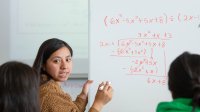Teaching Students How to Study Math
The most effective way to study math is not intuitive for a lot of students, so providing explicit instruction on this skill is essential.
Your content has been saved!
Go to My Saved Content.When did you first learn how to study math?
For me, it was during freshman year of college. I was frustrated when I got a C on my calculus midterm. It wasn’t the C that upset me. I just wanted the grade to represent my understanding, and in this case, I felt like it didn’t. I knew all of the concepts on the assessment but made a lot of errors that weren’t uncovered until after the test was returned.
In my first few years of teaching, I noticed my students having similar difficulties. Prior to assessments, I would give them a review day to prepare. During one of those sessions, my class was out of control when they were supposed to be studying. In debriefing and reflecting on the challenges we faced that day, I paused and bluntly asked the class, “How do you study math?” In that moment, I realized:
- The majority of my students had never been asked that question.
- Their misbehavior was the result of a lack of structure and guidance in how to navigate the day.
- How to study math is something that students should learn, and it’s something that I should teach.
Now at the beginning of each year—before I present my students with any content—I teach them how to study math. This allows them to see the purposeful intent in how everything we do in class during the year will contribute to their learning.
What to Do When Studying Math
Professor Rochelle Gutierrez has said, “Mathematics is not a noun, but a verb.” It’s not something we know; it’s something we do. When we do math, we learn math. Often students make the mistake of thinking that studying math is just reviewing notes or prior work. This perpetuates the detrimental misconception that mathematics is solely something to memorize. It’s impossible to memorize each solution pathway to the infinite applicable representations of mathematical concepts. (But chess grand master Magnus Carlsen comes close.)
I tell my students to replicate the modality in which they will be assessed, instead of attempting to memorize when studying. For example, if students are preparing for an individual assessment, they would ideally practice individually. If it’s a presentation of learning, they could practice presenting and demonstrating their work to peers, family, or friends. This would allow students to reflect and iterate on their performance before their assessment.
We all make mistakes. The goal of the studying process is for students to be able to catch and correct their mistakes before others evaluate their work. When studying, they want any mistakes that they would potentially make on the assessment to arise in their studying. Therefore, they could be prepared to potentially make and correct that mistake prior to the assessment.
Aligning Instruction to Studying
When studying for an individual assessment, students could do practice tests with answer keys or do problems that they have already completed (not looking at the work or answer as they rewrite the original task on a separate sheet of paper and work to complete it).
To prepare for this, I tell my class, “We can make mistakes; we just can’t keep them.” After all, mistakes provide learning opportunities, as they demonstrate an area for growth.
Scaffolding Student Agency
If students cannot do the task they are studying, then there is a scaffolded regression they could do to find their zone of proximal development in preparation for the assessment.
1. Students could look back at a similar problem they have completed to see what steps they may have missed, finish the task, and do another. This action reinforces the saying, “Practice doesn’t make perfect; perfect practice makes perfect.” It doesn’t matter how many practice problems they’re doing if they don’t get the right answer. I often tell my students, “Don’t practice until we get it right; practice until we can’t get it wrong.” I want my students to come into an assessment with the mindset that they have already done this and are ready to demonstrate what they have learned.
2. Students could reference their notes. This is where good note-taking is essential. It becomes a means for students to support themselves with rationale behind the concepts they are expected to know when performing the tasks.
3. Students could reach out to another student or the teacher for support.
When we provide our students with guidance in how to study, they see how they’re being set up for their hard work to lead to success. They recognize the connectedness between all of the academic resources they will encounter over the course of the year and how those resources will enable them to both learn and accurately demonstrate their learning.
